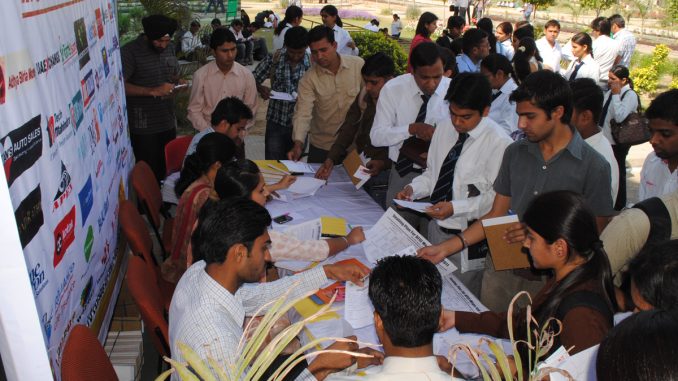
By Pranab Bardhan
Many people think that one of the major economic failures of the current government is in the area of jobs. It came to power promising jobs for ‘aspirational India’ in place of ‘doles’. While ‘doles’ remain largely in place, Labour Bureau data seem to suggest even an absolute decline in formal sector jobs over the last three years, instead of any significant rise.
The backlog of ‘surplus workers’ that include the underemployed in all sectors (as estimated in the India Employment Report 2016) exceeds 50 million workers this does not include the women who are often discouraged dropouts from the labour force. Rhetoric or electoral ‘jumla’ aside jobs, particularly formal sector regular jobs which the young in India hanker after, have been a chronic problem over several decades.
If one takes the whole period since 1972-73 when National Sample Survey started collecting employment and unemployment data on a comprehensive basis, job growth has been relatively sluggish (except for short spells, as in the first decade of this century, and that too mainly in the construction sector). Many alternative solutions for the job problem have been suggested, like larger investment in infrastructure (particularly electricity and roads), education and credit to small and medium enterprises. Some of these involve structural problems which can be resolved only in the medium to long run.
Others have pointed to stringent labour laws which inhibit firing (and therefore hiring) labour. Some state governments have relaxed those stringent laws over the last three years and it may be too early yet to find much conclusive evidence of that making a big difference in job creation. My own empirical hunch has been that labour law is a constraint, but it may not be the most important or even a binding constraint.
While the job crisis remains severe and potentially explosive in the socio-political sphere, three possible ways of relieving it have not received adequate attention. First, a policy of wage or payroll subsidies. A significant part of current budgetary subsidies, both at the central and state levels, are in the form of capital subsidies subsidies on interest or credit and tax concessions of various kinds for capital investment. We do not have precise estimates, but my back-of-the-envelope calculations suggest that these subsidies may come to 5% of GDP. A part of these subsidies, which currently encourage capital intensive methods of production, may be converted into wage subsidies.
In fact the same businessman in the formal sector may be paid the subsidies, but now for hiring more people rather than machines. A cap may be imposed on the wage subsidy on any particular job so that the incentive remains on hiring more people than on paying large salaries to particular employees. Similarly, possible scams in the form of fake payrolls may be avoided with appropriate biometric identification.
A second suggestion relates to skill formation. The current Skill India programme has not made much progress.The ministry of skill development has now abandoned the earlier much-hyped but unattainable target of training at least 300 million workers in new skills by 2022. Currently less than 5% of the total work force has formal vocational skills.Of about 3 million people who have received some training by July 2017 under the current scheme, less than 10% have reportedly received any job offers.
One possible remedy may be to encourage the business sector (particularly in local clusters) to get involved in the training of workers somewhat in the line of the German model, the world’s most successful vocational training programme. German business largely funds such programmes as this gives them an opportunity to look for and get as apprentice good-quality workers. In any case a vocational programme that is not integrated with a job placement programme is unlikely to be viable.
A third suggestion relates to the agricultural sector. While most young people even in farmer families now want to get out of their traditional occupation, whether one likes it or not, the demographics and occupational distribution of our labour force is such that for a long time agriculture will have to continue to be a main source of jobs. The important task is to make those jobs more productive and higher-paying.
The area where India has a large potential is in non-crop agriculture fruits, vegetables and livestock farming.These activities are also highly labour intensive. But for making this sector more productive and job creating at least two essential pre-requisites are (a) investment in cold chains and refrigerated transport; and (b) streamlining the marketing arrangements.
Agricultural marketing remains one of the most unreformed and cartelised sectors in India. More direct farm to-shop arrangements with minimum involvement of collusive intermediaries have to be forged. Our farms are (and will remain for quite some time) too small.They have to be amalgamated into farming companies or cooperatives at least for the sake of marketing (and input provision). The Amul model of collecting from small producers and then cooperatively marketing and distributing has to be extended all over India in these productive sectors of non-crop agriculture if profitable job creation is our objective.
These suggestions for job growth are within the realm of feasibility even in the short to intermediate time horizon. Meanwhile the time bomb of not enough jobs for our young people keeps ticking.
(The writer is Professor at the Department of Economics at University of California, Berkeley)
Source: Economic Times

Leave a Reply